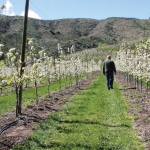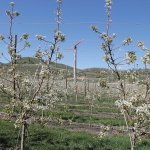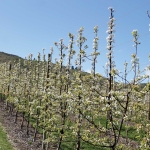A high-density Bartlett pear orchard at Monitor, Washington, which is trained as a fruiting wall, could start a revolution in pear production, Dr. Stefano Musacchi believes. Most pears grown in the Wenatchee Valley come from old, large, freestanding trees.
Musacchi doesn’t expect an immediate switch to high-density systems, because the traditional pear orchards are still profitable.
“But for people who want to expand or build a new orchard, I think it’s a nice way to go,” said Musacchi, who is a research pomologist with Washington State University.
The Bartlett pear orchard, owned by McDougall and Sons, Wenatchee, where Musacchi is doing his research, has trees spaced four feet apart with 12 feet between rows.
It was planted four years ago with four rows of d’Anjou to one row of Bartlett (as the pollinizer) but was grafted over a couple of years ago entirely to Bartlett. The trees are on Old Home Farmingdale 87 rootstocks and have been converted to a bi-axis system.
While apple orchards have been converted over the past few decades to high-density systems, the pear industry has been hampered by the lack of a dwarfing rootstock. Potential pear rootstocks are being tested, but Musacchi said he can’t wait another 20 years for a dwarfing pear rootstock to come on the market so he had to devise another solution.
With the bi-axis system, the vigor of the tree is divided in two. For the more vigorous d’Anjou variety, three axes might be needed.
The bi-axis system doubles the number of leaders, or axes, with the same number of trees per acre. It also doubles the number of shoots, and they are shorter because they compete with each other. Ideally, Musacchi likes branches to be around 10 inches long.
“If you spread the vigor on 44 branches instead of 22, you have a dramatic reduction of the growth,” he said. “It’s a simple idea, but it works. Splitting the vigor is the way to go with what we have available now. I think this can make a lot of difference in vigor control in our industry. If it proves we can do it and this is a nice way to go, I think this orchard is perfect to be mechanized.”
Mechanization
Already, Musacchi is testing mechanical pruning in the orchard. Because of the risk of trees becoming infected with fire blight through the cuts, it is done in the dormant season (March), rather than in early summer, as on apples. Objectives include overcoming blind wood, maximizing the quality and size of the pears, and minimizing pruning costs.
He also envisions that pest control will be more effective. The small canopy will be easier to spray, and pests such as pear psylla will find fewer places of refuge than in the big old trees with all the suckers at the top. In addition, it should improve harvest efficiency.
“Can you imagine if we can harvest with a platform?” Musacchi asked. “A dream for me is when we’ll be able to harvest 70 percent or more fruit from the ground. Now, we have 80 percent in the top of the trees.
“I’m really thinking that this orchard is for me a key orchard because it can provide a lot of information.” •









Leave A Comment